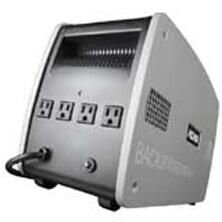Greetings,
Presently, I have 2 Quad CB1200 inserts on my ground floor, and just purchased a Quad Santa Fe freestanding for downstairs in the basement to help warm the kids' playroom and family TV room. My dealer has recommended a straight "out the back" vent pipe with the angled rain cap on it. I like the idea as it it has a neat appearance. However, I recall reading on this forum a while back that some members recommended against straight horizontal pipe without a any amount of rise due to quick backup of smoke in the house when the electricity goes out. I have the capability of using a generator wired into my circuit box when this scenario should happen, which is expected since ice has knocked out electricity in my city the last 2 years. However, it is a manual set up, so it will be 10-15 mins before the genset is hooked up, and running once the electricity goes out, which provides a great opportunity for a smoke - filled home. I discussed this with my dealer, and he said that not only has this not been an issue with other owners (via installs he has done), but Quad recommends the straight "out the back" install without any rise as it is easier to clean out, and reduces the amount of ash build up in the vent. Does anyone else have this same set up, or one that is similar? Have you had issues with smoke filling up the house when the electricity goes out? Comments welcomed.
Presently, I have 2 Quad CB1200 inserts on my ground floor, and just purchased a Quad Santa Fe freestanding for downstairs in the basement to help warm the kids' playroom and family TV room. My dealer has recommended a straight "out the back" vent pipe with the angled rain cap on it. I like the idea as it it has a neat appearance. However, I recall reading on this forum a while back that some members recommended against straight horizontal pipe without a any amount of rise due to quick backup of smoke in the house when the electricity goes out. I have the capability of using a generator wired into my circuit box when this scenario should happen, which is expected since ice has knocked out electricity in my city the last 2 years. However, it is a manual set up, so it will be 10-15 mins before the genset is hooked up, and running once the electricity goes out, which provides a great opportunity for a smoke - filled home. I discussed this with my dealer, and he said that not only has this not been an issue with other owners (via installs he has done), but Quad recommends the straight "out the back" install without any rise as it is easier to clean out, and reduces the amount of ash build up in the vent. Does anyone else have this same set up, or one that is similar? Have you had issues with smoke filling up the house when the electricity goes out? Comments welcomed.


